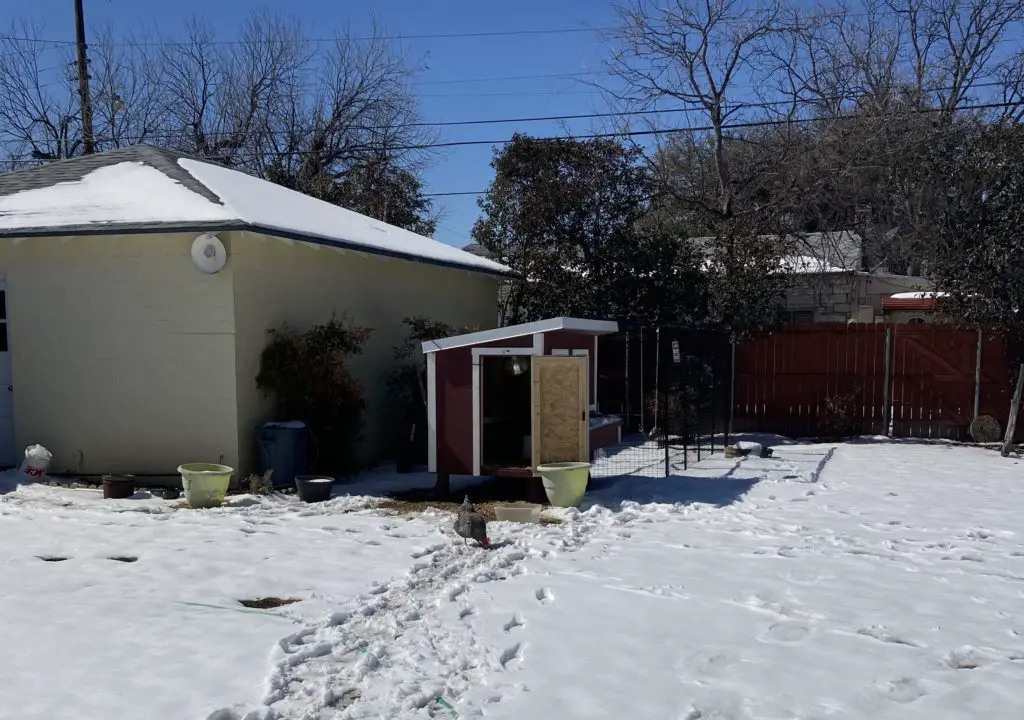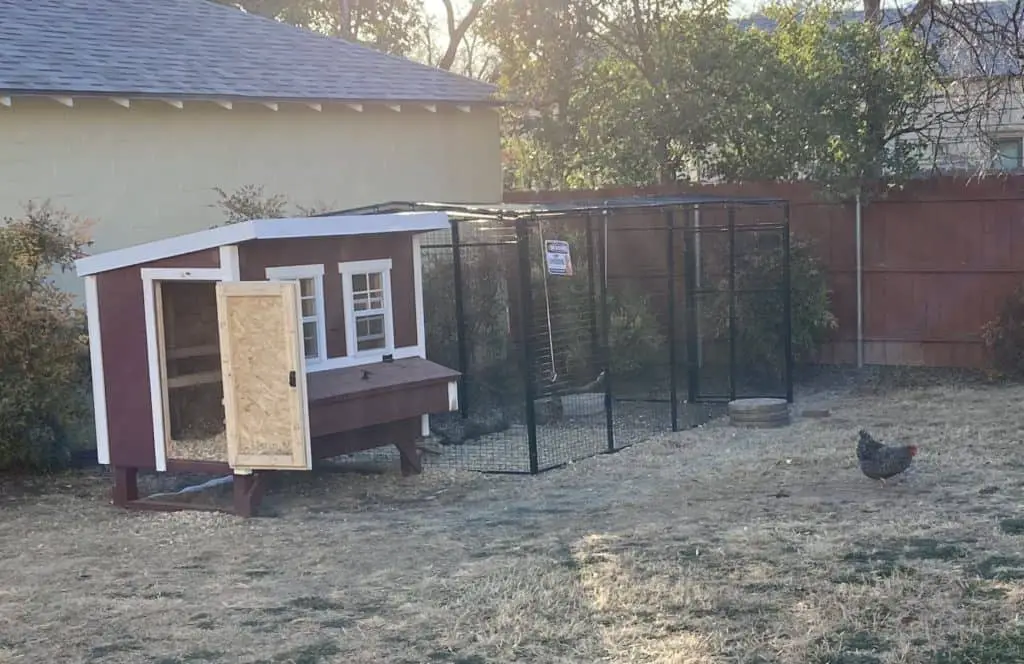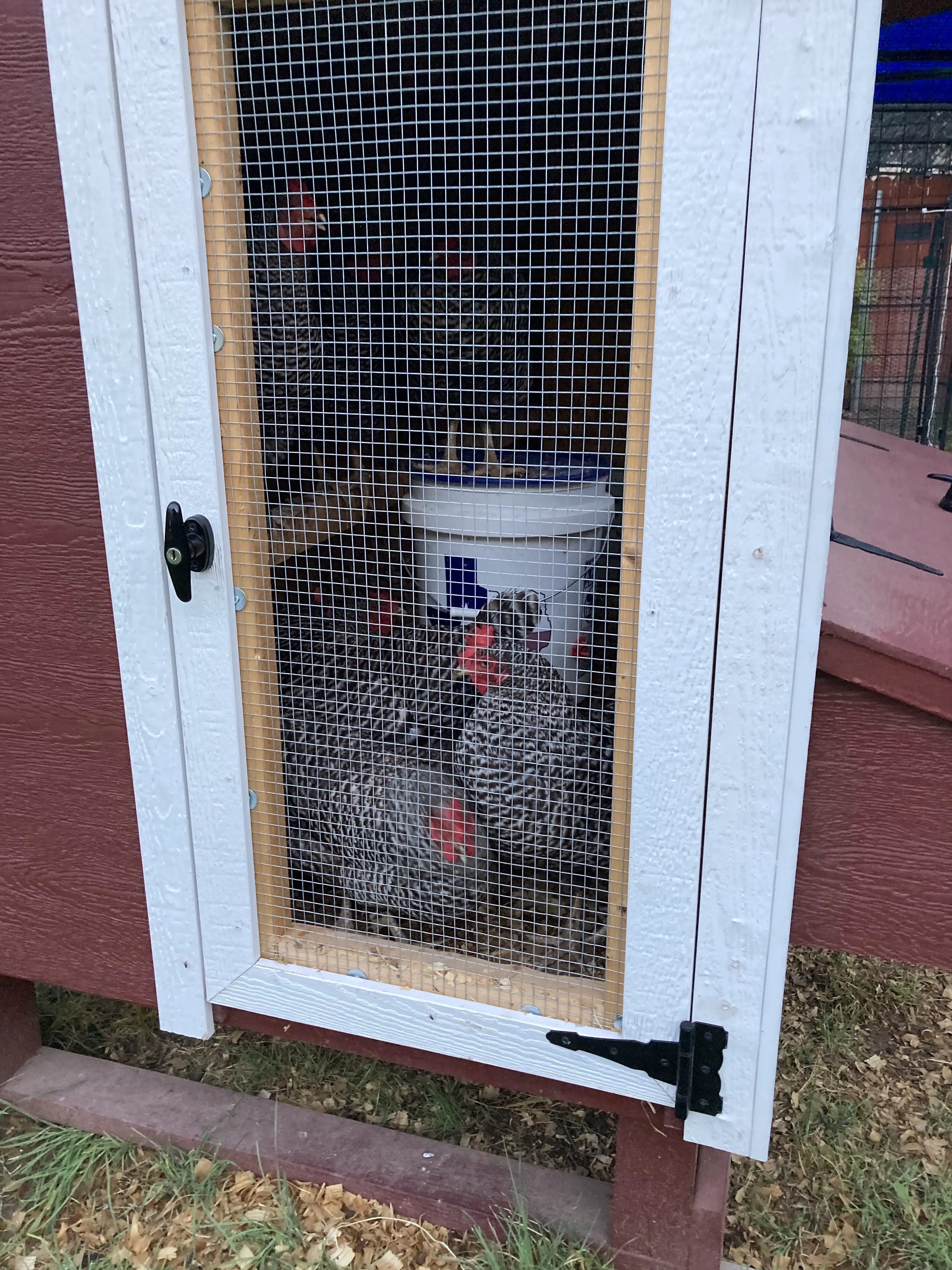One of the most important things you can do while preparing for new chickens is ensuring your flock has a safe and healthy place to roost at night and lay eggs during the day. Whether you buy a pre-made chicken coop or make one using materials you already have, there are several things that you will need to consider regarding the location of the coop, including how much sunlight or shade will be in the area throughout the year. Learn from my mistakes and take these factors into consideration so you don’t have to move your chicken coop, because once a coop is set up it can be hard work to move it to another place!
While sunlight is necessary for chickens, care should be taken with the heat that comes with the sunlight. A chicken coop needs to be in a location that does not get too hot during the summer but allows sunlight for the chickens. It’s also ideal if the location can be warmed by the sun during the winter.
Keep reading to learn the 7 factors to consider when finding the ideal location for the chicken coop and ideas for adjusting the amount sunlight and shade.
1. Location of coop should allow chickens access to sunlight
Chickens need access to sunlight throughout the day. Sunlight is necessary for the health of your chickens as it regulates egg laying, tells them when it’s time to sleep or awake, and relates to their absorption of Vitamin D3.
The chicken coop should be located in a place that allows the chickens access to sunlight on most days. I say most days because I know there are some places that have overcast weather regularly or less sunlight during certain parts of the year. The key is to make sure your chickens get access to sunlight because of the health implications.
Chickens require at least 14 hours of daylight per day to lay eggs. Daylight enters a chicken’s photosensitive gland in her eye that triggers ovulation. If this trigger does not happen, then a chicken will not ovulate and will not be able to lay an egg.
In addition, sunlight provides Vitamin D3. Vitamin D3 is a necessary nutrient for a chicken to maintain proper health. Vitamin D is needed for the assimilation of calcium. Calcium is a major ingredient in egg shells and when there is a deficiency in calcium, egg shells become weak and thin. Calcium needs increase with a hen’s age and in warm weather.
Vitamin D3 can be obtained through direct exposure to sunlight. The key here is that the sunlight must be direct and not through a window pane or filtered through a curtain in order for the Vitamin D3 to be properly assimilated in the body. In addition, sunlight during the middle of the day provides more exposure to Vitamin D3 than sunlight at the end of the day. To get the maximum benefit of exposure to sunlight for the Vitamin D3 benefits, chickens will need access to sunlight when the sun is highest, between 10:00 AM and 3:00 PM.
Chickens were not meant to live in a dark location with no sunlight so make sure wherever the coop is located that the chickens are still able to have access to sunlight.
2. Early morning sun is best during summer
It’s best to find a location for your chicken coop that gets early morning sun, especially during the summer, instead of late afternoon sun when it’s hotter outside. For chickens, extreme heat is more dangerous than frigid cold weather.
The optimal temperature for chickens is 70 to 75 degrees F. In this temperature range, chickens have optimal health, energy, and egg production levels. When temperatures rise above 85 degrees F, chickens will start to pant and engage in other behaviors to cool off their bodies.
Our first chicken coop got early morning sun and by about 3:00 PM during the summer it was in the shade. This was an ideal location for the coop with regards to amount and timing of sunlight.
With our current coop, it gets sun from about 9:00 AM to 6:00 PM during the summer, which means it gets way too hot during the day. This is why we have fans blowing in the coop windows, a tarp over the run, plenty of waterers, and have let the bushes in the run get overgrown to provide more shade. We have plans to move this coop to the other side of the yard where it will be shaded by a pecan tree during the summer.

For more information about chickens and heat, check out these posts:
- 9 Ways to Keep Chickens Cool During the Summer
- How Chickens Cool Themselves
- Will Chickens Stop Laying Eggs in Hot Weather?
3. Any amount of sunlight is great during winter
Locating your chicken coop in a place that gets any amount of sunlight during the winter will ensure your chickens get enough sunlight to continue laying eggs and will also help to keep them warm on cold days.
Chickens tend to stop laying eggs during the winter due to the shortened days. If they still have adequate access to sunlight during the winter, this will help them to continue laying eggs for longer. Also, keep in mind that when chickens molt they will slow down or stop laying eggs and this is usually during the fall or the first part of the winter.
A lot of chicken people online live in places that have an actual winter, unlike where I live in Texas where it gets really cold randomly and then 80 degrees the next day. Even in this environment, I think it’s important to try to locate the chicken coop in the sun during the winter and provide shade in the run for the days that get hot.

4. Chicken run should get sunlight at least part of the day
A good rule of thumb is to ensure your chicken run is located in a place that will get sunlight in all parts of the run for at least some part of the day. I would suggest placing your run in a location that gets both some shade and some sun during the day for the following reasons:
- UV rays from the sun will help to kill pathogens in the run. In the late 1800s, scientists discovered that UV rays from sunlight were able to kill several types of bacteria, including anthrax, plague, and staphylococcus. By allowing your run access to direct sunlight throughout the day, you might be able to keep the area free of any bacteria or viruses than can cause illness to your chickens.
- Chickens need Vitamin D3 from the sun. As previously mentioned above, chickens require Vitamin D3 as a necessary nutrient to maintain proper health. Direct time in the sun helps chickens to get this vitamin naturally.
- The sun will dry out the run after rain or snow. If your run is located solely in a shaded area, it is likely to be muddy and disgusting after a storm. The chickens will carry this mud back into their coop and it will inevitably end up on their eggs. A dry run will result in cleaner eggs and cleaner chickens.
- The sun will dry up droppings. Chicken droppings can be watery, mushy, or runny. The sunlight in the run will help to dry up these droppings which keeps them from sticking to the bottom of your shoes. In addition, it will help to keep your chickens healthy by drying up their fresh droppings so that it will not stick to any food that falls on the ground in the run. Eating droppings can result in chickens getting sick, so the cleaner the run, the more healthy your chickens.
- Sunlight in the run will keep your chickens warm on cold days by allowing them a place outside of the coop. On cold days, some chickens will try to get warm by staying in the coop. This is not ideal because it can cause conflict with the chickens that are in the coop laying eggs. It’s best for chickens to be in the run during the day so they are not disturbing laying hens in the coop.
- Chickens love to sunbathe. Chickens love to dust bathe and this activity will oftentimes be done in a sunny location. If you provide a nice dust bath area that gets sun during the day, your chickens will love you for it!
- While some sun is good, shade is important, especially on hot days. Chickens will most likely spend most of their time in a run, unless they free range. It’s important to make sure they have shade during the hottest parts of the day to help keep them cool.
At my house, the run is attached to the chicken coop. During the early morning, the run has shade from the shadow of the run. By mid-morning, there will be sun in the run as the sun rises. By late afternoon, the sun has set behind some trees so the run is shaded again.

It’s also important to keep track of the location of the sun throughout the year. For instance, during the winter when the sun is lower, there is more shade in the run during the day. During the summer when the sun is higher, the run has less periods of shade throughout the day and tends to have direct sunlight, which is why we have the tarp over the top of the run to provide shade. This tarp also keeps the run somewhat dry during rain so it’s multi-purpose.
A good mixture of sun and shade in your chicken’s run will result in a cleaner run and coop and will provide your chicken with many benefits to their health and well-being.
5. When the sun lights up the coop, then it’s time to let out the chickens
Another factor to consider when it comes to sunlight and your chicken coop is that as soon as the sun shines into the chicken coop, your chickens will be wide awake and probably squawking for you to let them out. This is something to consider in case you are not a morning person and would like an extra 10 minutes of sleep in the morning.
Chickens are awake when there is light. When there is enough light to see, the chickens will get antsy and ready to be let out of their coop. If the coop is positioned where it won’t get direct sun until a little later in the morning you might be able to buy a few extra minutes before you need to let them out.

Just keep in mind that positioning the coop in a part of the yard that gets sunlight later in the morning will only give you a few extra minutes before you need to let them out of the coop. The sooner you let chickens out after dawn, the better for their health, otherwise you might have a problem with lower egg production (discussed next).
6. Not enough sun during morning might result in lower egg production
As mentioned earlier, chickens require at least 14 hours of daylight per day to lay eggs. If they do not get this amount of sunlight in a day, their egg production will decrease.
Chickens have a very predictable schedule every day: they are awake and alert as the sun comes up, lay eggs in the late morning to late afternoon, then go to roost at dusk, and remain silently sleeping until the next day. If the chickens are exposed to sunlight too late in the morning, their egg production cycle can be disturbed resulting in ovulation occurring later in the day and maybe a day or two of missed egg laying.
During the winter months, the sunlight is less per day which is why chickens lay fewer eggs during the winter. This is a natural part of a chicken’s life cycle, but if you are wanting to maximize the eggs you get from your hens, it’s best to provide them with sufficient sunlight especially during the times of the year where there is more natural light during the day.
7. Artificial lights can also impact chickens
Chickens can have their health and well-being impacted by artificial lights. When determining the best location for a chicken coop, it can be easy to overlook the impact that artificial lights can have on your flock.
Artificial lights can inhibit the sleep of a chicken. When there is enough light to see, chickens will be awake and on watch for potential predators. In general, chickens require 6 to 8 hours of sleep every day. Sleep is essential to chickens to process new information and helps build their body’s natural immunity.
Make sure your neighbors don’t have a bright porch light that is shining in the coop all night long. Try to position the coop in your yard so that street lights don’t shine into the coop.
Another way artificial lights can impact chickens is through their egg laying. Factory farms using artificial lights in their chicken houses to keep the hens producing eggs throughout the winter. This seems a bit cruel to me since I think a chicken’s body was designed to get rest during the winter from laying eggs.
Producing eggs requires a lot of work for a chicken and when they produce eggs non-stop, they age much quicker and are more likely to experience ill health. This is why factory chickens don’t have long lives. The average lifespan of a factory chicken is 2 years, while the average lifespan of a backyard chicken is 8 years, with some well cared for chickens living up to 15 years.
Ideas for Adjusting Sunlight and Shade for Chicken Coop
With all these factors to consider, it can seem a bit daunting to find the perfect location for your chicken coop. If you do find a perfect location, congratulations! For the rest of us, here are some ideas for adjusting the sunlight and your chicken coop:
- Use tarps over the coop. Tarps are relatively inexpensive and easy to move. Use a tarp with a reflective side to help deter some of the heat that comes from the sunlight.
- Place the coop under a deciduous tree. The tree will have leaves to protect the coop during the summer from the heat. When the tree drops its leaves in the fall or winter, sunlight will be able to keep the coop warm. Examples of deciduous trees include maple, oak, and hickory trees.
- Place your coop on wheels. If there is no perfect year-round location for your chicken coop, consider placing it on wheels so that it can be moved.



1 comment
[…] 7 Factors to Consider for Sunlight and Your Chicken Coop […]
Comments are closed.